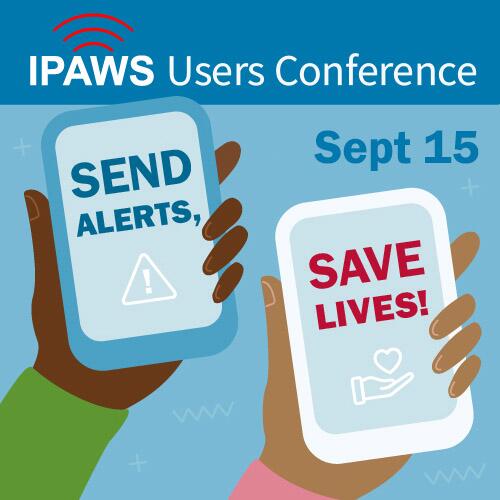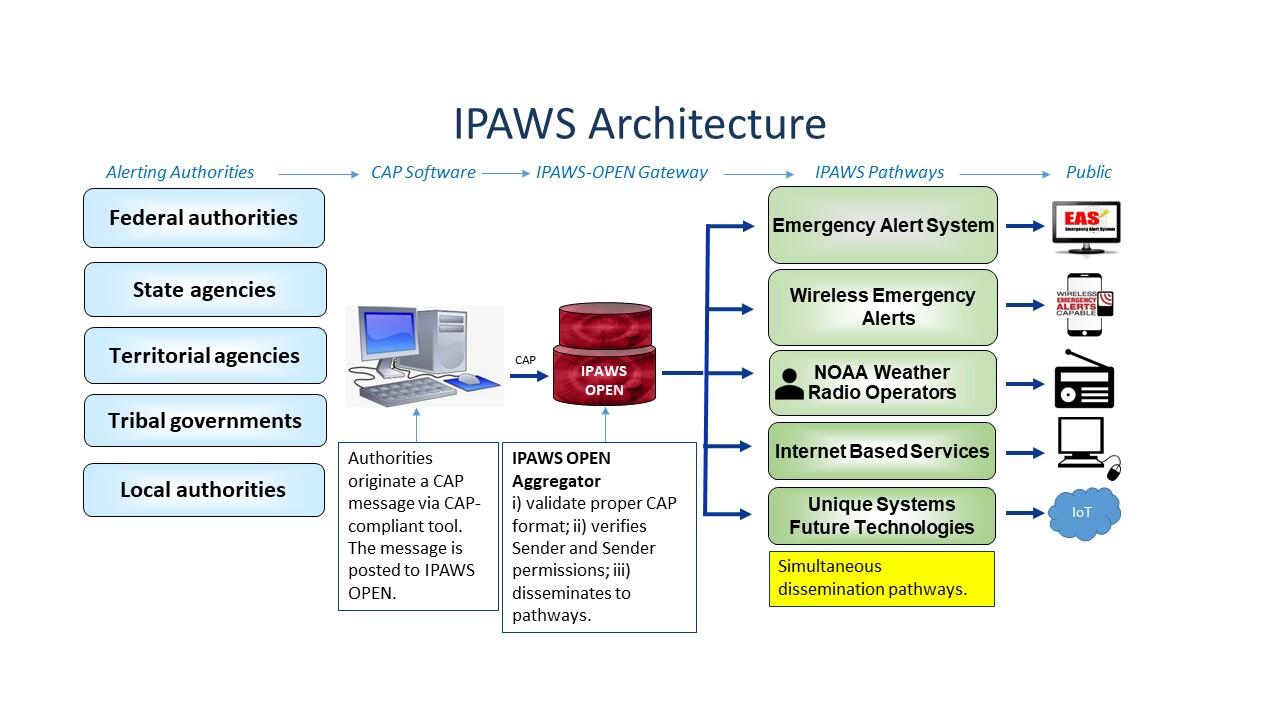The Integrated Public Alert & Warning System (IPAWS) is FEMA's national system for local alerting that provides authenticated emergency and life-saving information to the public through mobile phones using Wireless Emergency Alerts, to radio and television via the Emergency Alert System, and on the National Oceanic and Atmospheric Administration's Weather Radio.

Upcoming Events
Past Events
All sessions were recorded. If the recording is not available yet in the links below, check back soon.

News & Updates
IPAWS is pleased to announce the availability of IPAWS TSS 24 hours a day, 7 days per week, including holidays. The new toll-free number for the IPAWS Lab is 1-84-IPAWSLAB or 1-844-729-7522.
For several years, requests from Alerting Authorities have grown to include the availability of IPAWS Lab technical assistance after business hours. We have met the demand, and the IPAWS Lab will continue to provide a closed/safe environment for Alerting Authorities to improve alerting proficiency, assess operating procedures, train employees, and exercise processes.
FEMA and Bonneville Seattle have completed an important modernization at the emergency radio broadcast facility at Bonneville International’s KIRO-AM 710 in Seattle. This modernization project improves emergency alert systems that provide critical alerts and warnings to the public.
The KIRO-AM facility serves as a Primary Entry Point (PEP) station for FEMA’s National Public Warning System (NPWS), maintained under FEMA’s Integrated Public Alert and Warning System (IPAWS), and provides critical information to the public before, during and after incidents and disasters.
How IPAWS Sends Alerts
IPAWS allows Alerting Authorities to write their own message using commercially available software that is Common Alerting Protocol (CAP) compliant. The message is then delivered to the Integrated Public Alert and Warning System, Open Platform for Emergency Networks (IPAWS OPEN), where it is authenticated and then delivered simultaneously through multiple communication pathways. Through IPAWS, one message is created to reach as many people as possible to save lives and protect property.
Utilizing multiple pathways for public alerts increases the likelihood that the message will successfully reach the public. IPAWS is structured to facilitate this functionality.

Communication Pathways
The Emergency Alert System (EAS) delivers alerts via AM, FM and satellite radio, as well as broadcast, cable and satellite TV.
Cell phones and mobile devices receive Wireless Emergency Alerts based on location, even if cellular networks are overloaded and can no longer support calls, text and emails.
The National Oceanic and Atmospheric Administration (NOAA) delivers alerts through NOAA Weather Radio.
Alerts are also available from internet service providers and unique system developers.
State, local, territorial, and tribal alerting systems such as emergency telephone networks, giant voice sirens, and digital road signs may also receive alerts from IPAWS-OPEN, and future alerting technologies and systems can easily be integrated into IPAWS.
IPAWS Tools by Audience
Whether you're sending, receiving, developing or communicating about alerts, find the tools you need for your role in the Integrated Public Alert & Warning System.
General Public
- Where You Receive Alerts?
- Wireless Emergency Alerts
- Emergency Alert System
- AMBER Alerts
- Alerting People with Disabilities
IPAWS Program Governance
Broadcasters & Wireless Providers
IPAWS Technology Vendors & Developers

Have a Question?
Email us at ipaws@fema.dhs.gov or call (202) 212-2040
About the IPAWS Program
FEMA established the IPAWS program in 2006 by Presidential Executive Order 13407. Today there are more than 1,600 federal, state, local, tribal and territorial alerting authorities that use IPAWS to send critical public alerts and warnings in their jurisdictions.
Mission
IPAWS is guided by its mission IPAWS Strategic Plan: Fiscal Year 2014-2018 to provide integrated services and capabilities to federal, state, local, tribal and territorial authorities that enable them to alert and warn their respective communities via multiple communications methods.
Vision
The IPAWS vision is to provide timely alert and warning to the public in the preservation of life and property using the most effective means for delivering alerts available at any given time.

